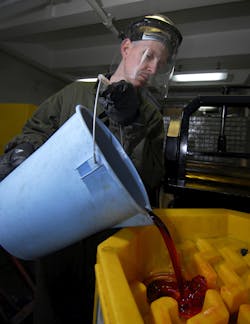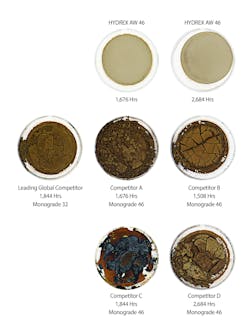This file type includes high resolution graphics and schematics when applicable.
Time and money: everyone wants more, especially when it comes to running a business. For many industrial hydraulic equipment applications, varnish formation can cause unnecessary downtime, which results in higher maintenance costs and lost productivity. Understanding how sludge and varnish deposits develop is essential to preventing the problems they cause, as is picking a hydraulic oil that resists formation of varnish and sludge in the first place.
Although hydraulic fluids don’t always get the attention they deserve, it has been clearly demonstrated that should be considered a key element in system maintenance – one that combats harmful sludge buildup and maximizes equipment uptime.
Sludge formation slows down operation of equipment and causes frequent cleanings or filter changes to be required. So the question is, how do you prevent it? Heavy-duty hydraulic systems endure tough operating conditions; running at high pressures at increasingly high speeds and working harder than ever before. Being aware of all the obstacles that stand between your equipment, your hydraulic fluids and your bottom line will enable you to make informed decisions that will keep production on schedule and extend the life of your equipment.
Origins of Sludge and Varnish
Small reservoirs, in particular, place stress on equipment and increase operating temperatures. That’s because a small reservoir undergoes more-frequent recirculation of the hydraulic fluid and, thus, a shorter resting period for air and heat to migrate from the fluid. In addition, contaminants have less volume to disperse, accumulating in higher concentrations and potentially impacting the fluid’s properties.
Even with a good filtration system in place, excessive sludge can build up and pass through hydraulic components. The result is plugged filters, accelerated equipment wear, and potentially, serious damage to the hydraulic pump. When coupled with high oil temperatures, sludge increases the potential for the formation of varnish, which starts off as a resinous substance and then forms hard deposits on components. As the equipment runs harder, the lubricant may break down faster, risking total system failure and costly equipment downtime.
Servovalves are especially sensitive to sludge and varnish deposits. Varnish is attracted to metal surfaces, and servovalves present a prime target. Varnish begins as a tacky, malleable residue that attracts debris and creates a sandpaper-like surface. Eventually, the pliable sandpaper ends up as a problematic, hard lacquer. It shoud be of no surprise that many hydraulic systems routinely needs servovalve maintenance or replacement.
Servovalves are often changed or cleaned because they are stuck in one position or produce erratic response to commands. Although a premium filtration system can dramatically reduce contaminants reaching the servovalves, another effective coarse of action is selecting a high-quality hydraulic fluid. The majority of a hydraulic fluid’s composition is base oil. A hydraulic fluid with a highly refined, oxidation-resistant base oil, in combination with an effective additive package, will produce less sludge, varnish, and deposits.
Industry Tests for Hydraulic Fluid
Testing is the first line of defense in the fight against sludge. Popular oxidation tests such as ASTM D4310 and ASTM D943 can be referenced to measure the relative performance of a fluid. ASTM D4310 evaluates the tendency of a mineral oil-based anti-wear hydraulic fluid to corrode in the presence of a copper catalyst while measuring the sludge formulation in the presence of oxygen, water, copper and iron at elevated temperatures.
Petro-Canada’s Environ MV hydraulic fluids reduce harmful sludge buildup in systems, as demonstrated by the ASTM D4310M extended oxidation test (2,600-hr duration). In this standard test, 99.5% oxygen flow, high temperature (95°C), and copper and steel catalysts were used to accelerate oxidation to determine the rate of acidity buildup in Environ and oils from other suppliers. After this extended test, the fluids were filtered and sludge samples examined. Environ MV outperformed competitors with significantly lower sludge formation at similar test hours.
Another important test for hydraulic fluids is ASTM D943. In this standard industry test, again, 99.5% oxygen flow, high temperatures (95° C), and copper and steel catalysts were used to accelerate oxidation to determine the rate of acidity buildup in hydraulic fluids. Petro Canada’s Hydrex AW and oils from other suppliers were subjected to this test. Later, fluids were filtered and sludge samples examined. The Hydrex AW had significantly lower sludge formation than the other oils — even after the Hydrex AW was tested for a longer duration.
Another important consideration is seal compatibility. A common issue with hydraulic equipment is leaks from broken seals or insufficient seal swelling. Oil leaks often result from oil seals becoming brittle and cracking, a problem typically related to the compatibility of a product’s base oil. Hydrex hydraulic fluids have excellent seal compatibility because they use base oil that is free of impurities. Using pure base oils helps prevent oxidation, which also translates into longer oil life.
In closing, sludge can be incredibly damaging to hydraulic components, ultimately causing unplanned downtime and increased maintenance costs. In conjunction with proper filtration, the selection of a quality hydraulic fluid can significantly reduce oxidation and sludge buildup. By putting these practices in place, you can proactively minimize the effects of sludge in heavy duty hydraulic systems.
Robert Farthing, Category Portfolio Manager—Hydraulic Fluids & Greases
Petro Canada, Calgary, AB, Canada
This file type includes high resolution graphics and schematics when applicable.





